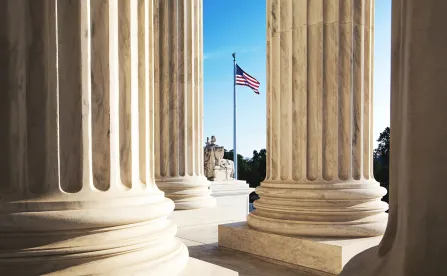Highlights
- Although the government retains authority to dismiss qui tam actions at any stage, the U.S. Supreme Court has ruled it may only do so after successfully moving to intervene in the action
- The government’s motions for voluntary dismissal of qui tam actions will be governed by Federal Rule of Civil Procedure 41(a), but will require courts to provide for a hearing where relator’s objections are heard
- The Court’s decision balances the government and relator’s interests by tempering the government’s authority with certain procedural requirements
On June 16, 2023, the U.S. Supreme Court issued its opinion in the case of United States ex rel. Polansky v. Executive Health Resources, Inc., announcing that the government, after initially declining to intervene, may dismiss False Claims Act (FCA) qui tam claims over a relator’s objections. The decision affirms the U.S. Court of Appeals for the Third Circuit’s “Goldilocks” approach, holding: 1) the government may move to dismiss a case at any time so long as it first formally intervenes, and 2) the government’s motion is evaluated under Federal Rule of Civil Procedure 41(a)’s generally applicable standards for voluntary dismissals (the Court noted that the standards “will be readily satisfied” in “most FCA cases”).
Background
When an FCA case is filed by a whistleblower, or relator, the government has the opportunity – before the complaint is unsealed and served on the defendant – to “intervene and proceed” with the action. If it decides to do so, “the action shall be conducted by the Government,” and if it chooses not to do so, the relator “bringing the action shall have the right to conduct the action.” Jesse Polansky filed this FCA qui tam lawsuit in 2012 and the relator’s complaint remained under seal for two years while the government investigated his claims. After the government initially declined to intervene in the action, the relator continued to prosecute the action on the government’s behalf.
Seven years after the relator filed his initial complaint – and after the parties spent millions of dollars on litigation – the government moved to dismiss the case under 31 U.S.C. § 3730(c)(2), which provides that the “Government may dismiss the action notwithstanding the objections of the person initiating the action if the person has been notified … [and provided] with an opportunity for a hearing.”
The district court granted the government’s motion over the relator’s objections and dismissed the case. Following a subsequent affirmance at the Third Circuit, the U.S. Supreme Court granted the relator’s petition for certiorari in order to resolve a four-way split among the federal courts of appeals regarding the government’s authority to dismiss qui tam actions where the government initially declines to intervene. Arguing that the government can never dismiss an FCA case in such circumstances, the relator emphasized the differences between 3730(c)(2) and (c)(4): Paragraph (c)(4) authorizes a court to stay discovery “whether or not” the government chooses to intervene, while Paragraph (c)(2) grants the government dismissal authority without elaboration. The relator claimed the lack of “whether or not” language in Paragraph (c)(2) meant the government could dismiss only where it intervened during the seal period. The government, meanwhile, insisted that it could always move to dismiss, arguing that because Paragraph (c)(2) does not explicitly say when it applies, it must apply all the time.
The Supreme Court’s ‘Goldilocks’ Approach to Intervention and Dismissal
In an 8-1 opinion authored by Justice Elena Kagan, the Supreme Court rebuffed both sides’ positions and affirmed the Third Circuit’s “middle way” approach.
The Court began by rejecting the government’s dismiss-anytime position. It noted that the government is not a party if it has not intervened – and “non-parties typically cannot do much of anything in a lawsuit.” The Court further observed that the government’s reading would render Paragraph c(4)’s “whether or not” language superfluous. Thus, the Court held that the government can move to dismiss only where it has first intervened in the case, and the FCA expressly authorizes the government to “intervene at a later date upon a showing of good cause.”
The Court then explained why the relator was wrong to claim that the government cannot dismiss even after it has intervened, saying the “consequence of a successful motion to intervene, in the FCA context as in any other, is to turn the movant into a party.” And once it is a party, the Court concluded, the government’s authority gives it “primary responsibility” for the case, including authority to dismiss the action over the relator’s objection. The Court noted that this “seal-agnostic view . . . fits the FCA’s Government-centered purposes.” Congress, the Court explained, “knew that circumstances could change and new information come to light,” and therefore “enabled the Government, in the protection of its own interests, to reassess qui tam actions and change its mind.”
After determining that the government may move to dismiss once it has intervened, the Court went on to resolve a prominent federal circuit split concerning the standard applicable to such motions. Again, the Court adopted “the Third Circuit’s Goldilocks position,” applying the standard for voluntary dismissals under Rule 41(a) of the Federal Rules of Civil Procedure. As the Court noted, this standard gives the government significant power to move for dismissal because “the Government’s views are entitled to substantial deference,” such a motion “will satisfy Rule 41 in all but the most exceptional cases.”
However, the Court observed that a district court’s application of this standard in FCA cases would differ from the norm in two ways: 1) the FCA requires district courts to hold a hearing on the motion, and 2) district courts should include the relator’s interests in deciding whether dismissal is proper. Applying these principles, the Court held that this case was “not a close call.” It affirmed the dismissal because the “Government gave good grounds for thinking that this suit would not do what all qui tam actions are supposed to do: vindicate the Government's interests.”
Notably, a dissenting opinion authored by Justice Clarence Thomas, as well as a concurring opinion authored by Justice Brett Kavanaugh (joined by Justice Amy Coney Barrett), expressly invited challenges to the constitutionality of FCA qui tam actions. These three justices expressed their view that “[t]here are substantial arguments that the qui tam device is inconsistent with Article II and that private relators may not represent the interests of the United States in litigation.” While this case did not raise such constitutional questions, these opinions are sure to prompt future litigation on this question.
Key Takeaways
While the Court’s opinion stops short of affording the government unfettered discretion to dismiss FCA cases, it is fair to characterize the practical result as “near-unfettered.” Under the Court’s decision, the government must first provide “good cause” for intervening, which the Third Circuit had understood to mean “simply a legally sufficient reason.” After intervening, the government can unilaterally dismiss the lawsuit so long as it meets the lenient requirements of Rule 41(a). Together, these guidelines provide the government wide latitude to dismiss when it demonstrates that FCA litigation is not in the government’s interest, including, for example, when a matter threatens to impose significant discovery costs on federal agencies or interferes with federal policy priorities. The Court’s opinion also confirms the U.S. Department of Justice’s 2018 Granston memorandum guidance, which endorses dismissal of cases that are frivolous, parasitic or opportunistic, or otherwise contrary to the government’s policies or programs.
For corporations or individuals facing FCA lawsuits, the upshot of the Court’s opinion is largely positive. Now, even at later stages of litigation (e.g., mid-discovery or pre-trial), defendants have the opportunity to seek assistance from the government to dismiss meritless FCA actions. And while the opinion also underscores the government’s authority to intervene and direct the litigation at any time – which may occasionally prove detrimental to defendants – this authority was already well-established. Accordingly, defendants should be pleased with the Court’s decision and consider raising the sweeping constitutional arguments noted in the concurring and dissenting opinions.







 />i
/>i

